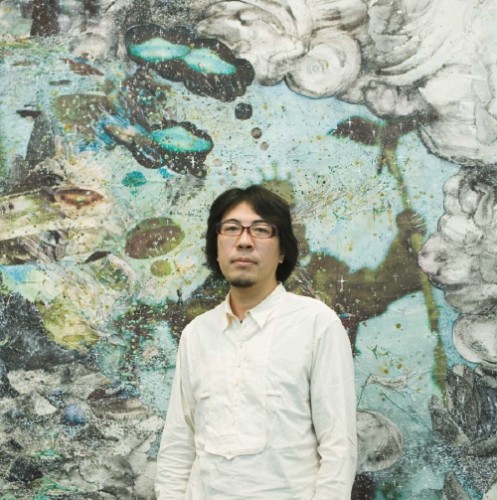Things we have no choice but to call art
Text: Yamagishi Kaoru (ART iT), Photo: Nagare Satoshi
 J 2009 (detail)
J 2009 (detail) Sumi, whitewash, metallic powder, and acrylic on washi 250 x 400 cm
This year, an artist whose work is often described as “new Nihonga” but who himself has always struggled with the label won the VOCA Prize, regarded by many as a passport to success for up-and-coming contemporary artists.
“Having been born and raised in Nara and having learnt to paint in the ancient city of Kyoto, when the Nihonga boom occurred I set out to create ‘proof’ of what I thought Nihonga should be today, but partly as a result of burnout from this overly theoretical approach, I ended up creating a style of my own that was neither contemporary art nor Nihonga but grew out of my own experience of living in Nara. I think perhaps this style has more or less taken shape.”
Not satisfied with existing genres, Mise pursued a form of expression that grew naturally out of the world around him, questioning everything from the materials, techniques, and even the supports he used, and eventually coming up with a collage technique that involved pasting together tiny scraps of paper on which he had previously painted. According to Mise, this is an attempt to throw himself off balance by introducing multiple perspectives, as well as enabling him to expand his pieces or fold them up into a more compact size depending on the space available.
“In competitions like high school baseball or the World Baseball Classic, representatives from various countries and regions play together, but the rules are the same,” says Mise. “Ideally speaking, you have people turn up with a form all their own but who can hit amazing homeruns. In my case, I want to create pieces that have a form of their own but that can also compete as contemporary art.” In art, a homerun equates to “being knocked flat the moment one sets eyes on a painting”. According to Mise, he wants to produce work that belongs to the category of art that words cannot describe, to produce sincere art in the kind of local environment he finds himself in at the moment.
In his award-winning work, J, Mise has used a variety of materials including acrylics, sumi, whitewash, metallic powder, and pigments he himself made. As well, the picture plane – which contains a mixture of elements of various sizes including the hands of a giant statue of the Buddha, the Loch Ness monster, and UFOs – is inlayed with countless crosses that represent light.
“People say that my work is chaotic and should be more structured, or that my feelings are reflected too strongly in my work, but at the moment I’m happy with things as they are. You could say I’m a modern romantic. In the end, humans are completely isolated. I think it’s far too presumptuous of artists to say that art can save people, but you’ll notice that my works glitter. That’s the last thing I do when I make a painting, and it represents a desire on my part to offer a kind of blessing to the world. I think it’s nice that in the end the paintings themselves emit light.”
Mise was teaching art at a high school in Nara, but since April he has been teaching a Nihonga course at the Tohoku University of Art and Design in Yamagata. I’m sure I’m not alone in looking forward to seeing what kind of stimulus this new environment of Yamagata has on the artist and what kind of new works emerge as a result.
Originally printed in ART iT 26 June 2009
